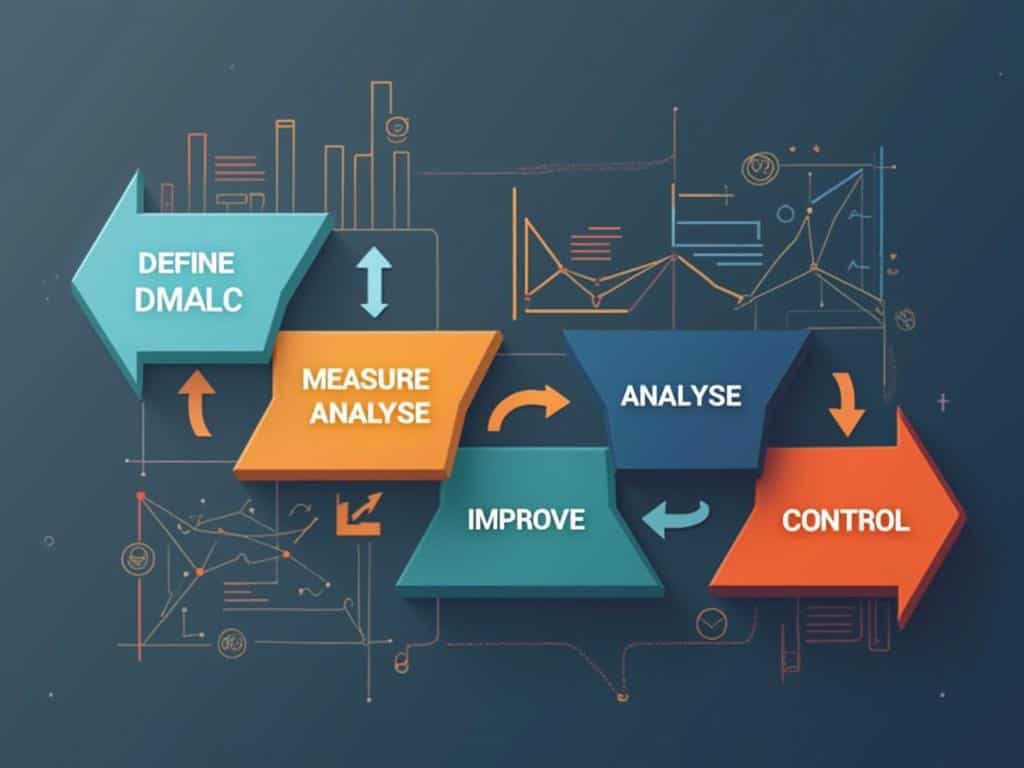
The DMAIC Methodology for Process Improvement
The DMAIC project delivers a structured, data-driven method for boosting process performance across industries. This five-phase approach helps organizations identify, analyze, and eliminate inefficiencies, turning business challenges into improvement opportunities.
Key Takeaways:
- The DMAIC framework consists of five sequential phases: Define, Measure, Analyze, Improve, and Control.
- Each phase focuses on specific objectives, from problem definition to implementing and sustaining process improvements.
- The methodology emphasizes data-driven decision-making and root cause analysis.
- DMAIC projects can help organizations achieve significant performance gains, potentially up to 50% efficiency improvement.
- The approach is adaptable and applicable across multiple industries, including manufacturing, healthcare, finance, and technology.
The DMAIC methodology stands as a cornerstone of Six Sigma process improvement efforts worldwide. You’ll find this approach particularly effective because it breaks down complex problems into manageable steps. Each phase builds logically upon the previous one, creating a comprehensive roadmap for success.
Companies implement DMAIC to eliminate waste, reduce variation, and optimize processes. This practical approach focuses on tangible results rather than theoretical concepts. The structured nature of DMAIC prevents teams from jumping to solutions before understanding root causes.
Data drives every decision in the DMAIC process. You collect and analyze information systematically, which leads to more accurate conclusions and effective improvements. This eliminates guesswork and subjective opinions from the improvement process.
DMAIC projects typically involve cross-functional teams. These diverse perspectives enhance problem-solving capabilities and ensure comprehensive solution development. Team members develop valuable skills throughout the project that benefit future improvement initiatives.
The control phase distinguishes DMAIC from other methodologies. You don’t just implement changes; you establish mechanisms to maintain improvements over time. This sustainability factor provides lasting value to organizations that properly execute DMAIC projects.
DMAIC works across various business sectors. Whether in manufacturing, healthcare, or financial services, the core principles remain consistent while the specific tools and applications adapt to each environment. This flexibility makes it a valuable methodology for nearly any organization seeking process excellence.
“The DMAIC methodology empowers organizations to transform complex challenges into measurable improvements by systematically identifying and eliminating process inefficiencies. With its structured five-phase framework, organizations can achieve significant performance gains through data-driven decision-making across diverse industries.”
Understanding the DMAIC Framework
The DMAIC framework is a comprehensive methodology for tackling complex business problems in your organization. This data-driven, structured approach helps you enhance performance and meet customer expectations across various industries including manufacturing, healthcare, finance, and technology. Every dmaic project follows five sequential phases designed to identify and eliminate process inefficiencies and variations.
The Five Phases of DMAIC
When implementing a dmaic project, you’ll work through these distinct phases:
- Define – Create a detailed project charter outlining objectives and customer requirements. This phase involves conducting stakeholder analysis and Voice of the Customer (VOC) research to establish clear, measurable project goals. By precisely defining the problem, you’ll prevent scope creep that can derail your improvement efforts. This phase typically takes 2-3 weeks.
- Measure – Develop robust data collection methods and identify Key Performance Indicators (KPIs) that matter to your process. Use process maps and capability analysis to establish reliable baseline performance metrics. Tools like Pareto charts, control charts, and run charts help validate your measurement systems for accuracy.
- Analyze – Apply statistical and qualitative techniques to uncover root causes of process variation. Your dmaic project will benefit from methods like Fishbone diagrams, the 5 Whys technique, and Failure Mode and Effects Analysis (FMEA). This phase is crucial for identifying critical inputs affecting performance and confirming hypotheses with data-driven evidence.
- Improve – Develop solutions backed by data analysis. Techniques such as brainstorming, Design of Experiments (DOE), and pilot testing help align improvements with business goals and customer needs. Compare pre- and post-improvement metrics to validate your dmaic project’s effectiveness and continuous improvement approach.
- Control – Establish comprehensive control plans and monitoring systems to sustain gains. Create standardized documentation, conduct regular performance audits, and maintain long-term process improvements. This phase helps foster an organizational culture of continuous improvement.
A well-executed dmaic project provides a structured pathway to enhance your process performance. By following this systematic approach, you’ll be able to address complex business challenges methodically and achieve measurable improvements. The framework’s emphasis on data-driven decision-making ensures that solutions are targeted at the actual root causes rather than symptoms, making it an invaluable tool for root cause analysis and process excellence.
Organizations that implement a structured methodology like DMAIC can achieve process improvement and efficiency gains up to 50%.
forbes.com
Defining the Problem and Project Scope
Starting a DMAIC project successfully hinges on properly defining the problem and establishing clear boundaries. This crucial first phase lays the foundation for all subsequent work and determines whether your improvement efforts will deliver meaningful results. Your DMAIC project begins with creating a detailed project charter that outlines specific objectives and identifies critical customer requirements.
During this phase, you’ll conduct thorough stakeholder analysis to understand who’s affected by the process and whose input matters most. Voice of the Customer (VOC) analysis helps capture expectations directly from those who experience your product or service. These insights enable you to develop strategic planning that addresses genuine pain points rather than symptoms.
Establishing clear, measurable project goals is essential for your DMAIC project success. These goals should follow SMART criteria (Specific, Measurable, Achievable, Relevant, Time-bound) to provide direction and accountability. When defining your DMAIC project scope, precision prevents the common pitfall of scope creep—where projects gradually expand beyond their original boundaries.
Key Elements of Problem Definition
Effective problem definition in your DMAIC project requires addressing several critical components:
- Problem statement: Clearly articulate what’s wrong, where it occurs, when it happens, and its impact
- Business case: Quantify the financial or operational impact of the current problem
- Goal statement: Define specific, measurable targets for improvement
- Project boundaries: Explicitly state what’s in-scope and out-of-scope
- Team composition: Identify core team members and subject matter experts
- Timeline: Establish a reasonable schedule, typically 2-3 weeks for this phase
Remember that investing time upfront in properly defining your DMAIC project pays dividends throughout the improvement cycle. Rushing through this phase often leads to misaligned efforts and disappointing results. By implementing proper risk response strategies, you can identify potential roadblocks early and plan mitigation actions.
This foundational phase of your DMAIC project creates alignment among stakeholders, establishes clear success criteria, and prevents wasted effort on poorly defined problems. When done properly, it provides the clarity and focus needed to drive meaningful process improvements in the subsequent phases.

Measuring Current Process Performance
The measurement phase is a critical component of your DMAIC project where you’ll establish baseline metrics to understand how your process currently performs. During this phase, you’ll need to develop a robust data collection methodology that captures relevant information about your process. This involves identifying and tracking Key Performance Indicators (KPIs) that align with your project goals and customer requirements.
Process mapping serves as a fundamental tool in this phase of your DMAIC project. By creating detailed visualizations of your current workflow, you’ll identify potential bottlenecks, redundancies, and areas for improvement. These maps provide a clear understanding of how work flows through your system and highlight opportunities for enhancement.
Your measurement efforts should focus on establishing reliable baseline performance metrics. These benchmarks will serve as comparison points to evaluate the effectiveness of future improvements. When conducting a DMAIC project, it’s essential to utilize various measurement tools including:
- Pareto charts to identify the vital few causes contributing to most problems
- Control charts to monitor process stability and detect variations
- Run charts to track performance trends over time
- Capability analysis to determine if your process meets specifications
Measurement System Validation
A crucial aspect of the measurement phase is validating your measurement systems for accuracy. Without reliable data, your entire DMAIC project could be compromised. Measurement System Analysis (MSA) helps ensure your data collection methods are consistent and accurate.
The table below outlines key activities in the measurement phase of a DMAIC project:
| Activity | Purpose | Outcome |
|---|---|---|
| Process mapping | Document current workflow | Visual representation of process steps |
| KPI identification | Determine critical metrics | Clear measurement targets |
| Data collection planning | Establish methodology | Structured approach to gathering information |
| Measurement validation | Ensure data reliability | Confidence in collected metrics |
| Baseline establishment | Document current performance | Reference point for improvement assessment |
By thoroughly measuring your current process performance, you establish the foundation for the subsequent analysis phase. This critical groundwork allows you to make data-driven decisions throughout your DMAIC project journey. The measurement phase typically requires careful planning to avoid common project management mistakes related to insufficient or inaccurate data collection.
Remember that your DMAIC project success hinges on the quality of your measurements. Taking time to establish reliable metrics will pay dividends throughout the remaining phases as you work toward process improvement and sustained excellence.

Analyzing Root Causes of Process Variation
Finding the true sources of process variation is critical to any successful DMAIC project. The analyze phase bridges the gap between measuring current performance and implementing solutions. You’ll need to employ both statistical and qualitative techniques to uncover why your processes aren’t performing as expected.
A well-executed DMAIC project requires thorough investigation of root causes before jumping to solutions. Start by examining your data through statistical analysis to identify patterns and relationships between variables. This helps separate random variation from special causes that need addressing. Conducting a comprehensive root cause analysis prevents you from treating symptoms rather than underlying problems.
Essential Root Cause Analysis Tools
When working on your DMAIC project, leverage these powerful analytical techniques:
- Fishbone (Ishikawa) diagrams: Map potential causes into categories like people, methods, machines, materials, measurements, and environment
- 5 Whys technique: Repeatedly ask “why” to drill down to fundamental causes
- Failure Mode and Effects Analysis (FMEA): Identify potential failure points and their impacts
- Hypothesis testing: Use statistical methods to validate or reject potential causes
- Regression analysis: Determine relationships between process inputs and outputs
- Process capability studies: Compare process performance against requirements
The analyze phase typically consumes 20-30% of your DMAIC project timeline. Don’t rush this crucial step, as incorrect root cause identification leads to wasted improvement efforts. Continuous improvement depends on accurately pinpointing what drives process variation.
Your DMAIC project success hinges on transforming data into actionable insights during analysis. Cross-functional teams often uncover unexpected causes that weren’t apparent during initial problem definition. When analyzing process variation, focus on separating correlation from causation through rigorous validation of hypotheses with data.
Always prioritize root causes based on their impact on your critical outputs. This ensures your DMAIC project addresses the vital few factors driving most of the variation. Process improvement systems function best when they target the most significant opportunities first.
Organizations that effectively address the root causes of process variation can achieve a reduction in operational costs by as much as 25%.
forbes.com
Implementing Targeted Improvements
After identifying root causes in your DMAIC project, you’re ready to implement solutions that directly address the identified issues. This phase transforms analysis into action through strategic, data-driven improvements. You’ll need to develop solutions that not only fix problems but also align with your organization’s objectives.
Your DMAIC project success depends on using the right techniques to generate and test potential solutions. Start with structured brainstorming sessions that encourage creative thinking while focusing on addressing the specific root causes identified in the analysis phase. When conducting these sessions, make sure to include team members from different departments who can provide diverse perspectives.
Here are key approaches to implement effective improvements in your DMAIC project:
- Design of Experiments (DOE) to systematically test variables and their interactions
- Pilot testing to validate solutions in a controlled environment before full implementation
- Cost-benefit analysis to prioritize solutions with the highest ROI
- Change management strategies to ensure smooth adoption of new processes
- Stakeholder management to maintain support throughout implementation
A critical success factor in any DMAIC project is the ability to secure sponsor commitment for implementing changes. Your solutions must be aligned with both business goals and customer requirements. This balance ensures that improvements address technical issues while delivering meaningful value.
When implementing improvements, you should create a detailed action plan that includes:
Improvement Implementation Roadmap
The effectiveness of your DMAIC project relies on a structured implementation approach. You’ll need to develop a clear timeline with assigned responsibilities and expected outcomes. Use action logs to track progress and maintain accountability throughout the implementation phase.
Measuring the impact of improvements is essential for demonstrating the value of your DMAIC project. Compare pre-implementation and post-implementation metrics to quantify benefits. This data provides tangible evidence of success and helps justify the resources invested in the project.
The following table illustrates a typical comparison of key metrics before and after DMAIC project improvements:
| Performance Metric | Pre-Improvement | Post-Improvement | Improvement % |
|---|---|---|---|
| Cycle Time | 45 minutes | 28 minutes | 38% |
| Defect Rate | 5.2% | 1.8% | 65% |
| Process Capacity | 120 units/day | 185 units/day | 54% |
| Customer Complaints | 18 per month | 6 per month | 67% |
When implementing solutions, you must also anticipate potential challenges. Effective DMAIC project management requires proactive risk planning to address obstacles that might emerge during implementation. This forward-thinking approach helps maintain momentum and prevents project delays.
Sustaining Continuous Process Excellence
After implementing improvements in your DMAIC project, you’ll need robust strategies to maintain gains and prevent regression. A comprehensive control plan serves as the foundation for sustaining excellence in your process improvement initiatives. This critical phase ensures your DMAIC project delivers lasting value rather than temporary fixes.
Your control plan should document standard operating procedures, monitoring frequencies, and response protocols for when metrics fall outside acceptable ranges. By implementing continuous improvement practices, you’ll extend the benefits of your DMAIC project well beyond the initial implementation phase.
To effectively sustain your process improvements, implement these essential elements:
- Statistical process control charts to monitor key metrics
- Regular process audits to verify adherence to new standards
- Response plans for addressing performance deviations
- Documented procedures accessible to all team members
- Training programs to ensure knowledge transfer
- Scheduled reviews to identify further improvement opportunities
Building a Culture of Improvement
The ultimate success of any DMAIC project depends on cultivating an organizational mindset that values ongoing enhancement. You’ll need to recognize team members who identify improvement opportunities and implement changes that align with your DMAIC project goals.
Regular performance reviews help track the sustainability of your DMAIC project outcomes. By establishing a cadence of weekly, monthly, and quarterly check-ins, you can review implementation progress and make necessary adjustments. These reviews should examine both process metrics and the effectiveness of your control mechanisms.
Training plays a crucial role in sustaining your DMAIC project benefits. When team members understand not just how to follow new procedures but why they matter, compliance improves significantly. Your training should cover the technical aspects of the DMAIC project and emphasize the connection between individual actions and overall process performance.
Documentation serves as the backbone of your control system. Comprehensive, accessible documentation ensures consistency across shifts, locations, and team changes. Your DMAIC project documentation should include process maps, standard work instructions, troubleshooting guides, and escalation procedures for exceptional situations.
By integrating these sustaining elements into your DMAIC project methodology, you’ll transform what could be a one-time improvement into a foundation for ongoing excellence. This approach ensures your organization maximizes the return on investment from each DMAIC project while building capabilities for future process optimization efforts.






